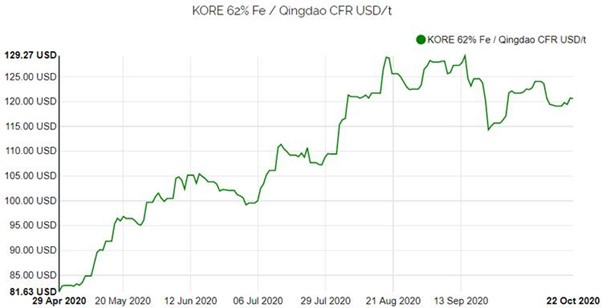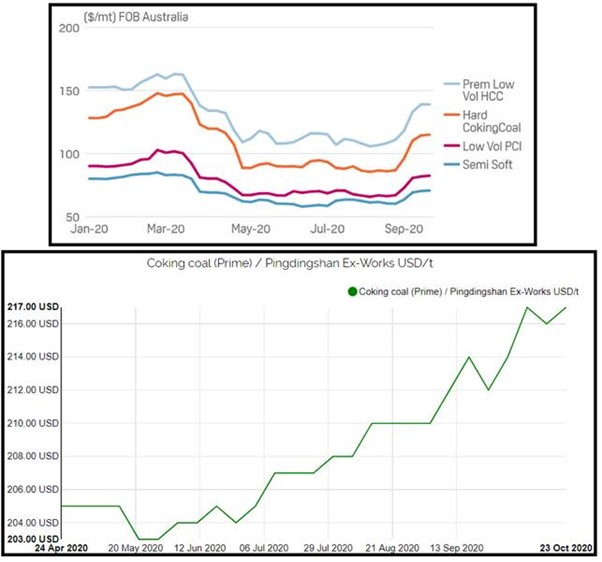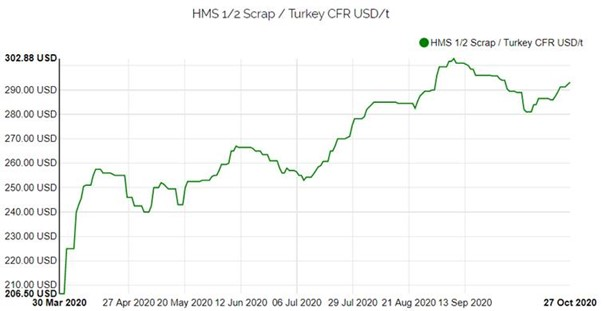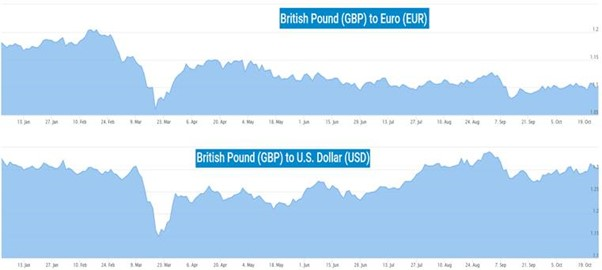Dear All Steels Customers,
Changes in the steel market certainly continue to move at significant
pace, and the forecasts we predicted in our mid-August note have very much all
now come to fruition. Hence, many of our customers have been asking for
our considered view on the current and foreseeable market situation, so here is
another relatively succinct update on observations, and our forecast for the
most likely changes ahead.
Understandably the resurgence of Covid-19 is causing further
confusion and uncertainty for us all. However, it is also fair to say
that most countries around the world seem to be taking the stance that the
industrial world cannot be allowed to suffer, and construction markets all
appear to be strong as governments advance their infrastructure projects to
assist employment. “The Get Britain Building Campaign” certainly still
looks to be a top initiative in the UK, and if we look at the sales statistics
produced by the National Association of Steel Service Centres (NASS) it is
evident that demand for structural sections, merchant bars and hollow sections
have returned back, indeed since July, to pre Covid-19 levels.
Our own UK rolling mills are also very busy and overtime
working is now starting to be applied to keep up with demand, so the speed of
positive turnaround of our industry from being in a rather dark place in the
spring is quite extraordinary.
For simplicity, we have started off by updating the usual
graphs, which we last presented to you in mid-August, and that we typically
follow on a daily basis as it is these fundamentals that drive steel prices
combined with supply and demand.
Iron Ore

Iron ore prices clearly remain
strong. Recent concerns have been expressed that increased mining
capacity coming on stream would result in a price softening and whilst the bull
run came to a halt in mid-September prices once again seem to be on an upward
trajectory.
China's crude steel output is now
estimated to exceed a record breaking 1 billion metric tonnes this year.
What is evident from media reports
is that China’s crude steel production has been running at very high levels
since May with consumption being lifted by the country’s infrastructure boom,
and underpinned by their manufacturing sector. Such activity is probably
now sufficient to keep iron ore hovering around its current high levels.
When considering ratios of iron ore
usage to the manufacture of steel it cannot be ignored that this element alone
is adding circa £52 per tonne to BOS route steel-making costs since the end of
April’s low point!
1.7t of iron ore is used to
make a tonne of steel.
Coking Coal

Like most commodities coking coal
prices recovered sharply following the first wave of the Covid-19 pandemic.
As seen with iron ore, Chinese BOS
route steelmakers are producing crude steel at a rate of knots with daily
output records being recorded in September.
With such strong demand coking coal
prices must logically stay strong, which the graph reflects from one of China’s
major domestic sources.
The top graph also shows FOB
Australia prices that are a good illustration of the recovery following the price
decline at the end of Q1.
Moreover, only this week severe
heavy rainstorms and floods are once again making headline news in Australia’s
major mining territories, and we all know what impact this can have on both
iron ore and coking coal prices.
0.7t of coking coal is used
to make a tonne of steel.
Scrap

As expressed in previous steel
bulletins Turkish imported scrap prices are always the most reactive to supply
and demand and other world steel events.
The graph therefore naturally
depicts general steel price movement and little explanation is required to
where steel prices appear to be trending.
Clearly iron ore and scrap prices
are currently moving in tandem, so both electric arc and BOS route steelmakers
both face the pressure of rising costs.
Unsurprisingly, Europe and UK scrap
prices are generally moving in the same upward direction, so there is no
geographical immunity to such increases in steel-making costs.
We also picked up news yesterday
that the Chinese are reappearing in the world market buying up scrap and this
could cause a serious uplift in scrap prices.
1.1t of scrap is used to
make a tonne of steel.
Exchange Rates

The £ sterling recovered quickly from
the initial shock of the Covid-19 outbreak, but it still remains weaker than
its year opening position especially against the Euro. Such an outcome
only serves to firm up imported steel and steel-making raw material costs.
In an environment where we have
American elections and Brexit negotiations closer to home it will be a volatile
time for the £ sterling, and we would shortly expect to see some significant
movement, but the direction is currently too difficult to call.
If you look at the value of the £
sterling against the Euro in particular, which is most relevant to the UK, the
devaluation of the £ sterling here has added circa £36 per tonne to imported
steel costs from mainland Europe since the start of the year.
All shipping and road transport for
deliveries to the UK are also Euro based, so this is also adding additional
costs to imported prices from the EU.
Oil Prices

As is usually the norm the oil
price mirrors the world’s general economic trends.
It is certainly reflective of what
we have seen in the UK, with June and July showing the strong bounce back we
have seen in steel demand.
It equally shows some confusion in recent months
as the Western world wrestles with further uncertainty of the Covid-19 second
wave.
On balance, we would say it shows improved confidence in the economy.
Whilst all these graphs convey a positive message for
strengthening steel prices the same health warning applies again here that the
Covid-19 pandemic could return to ultimately bite more severely as we progress
through the cold winter months ahead.
In the section below, we have tried to give a short overview
on each product group. The underlying message however is that from the
selection of graphs above is that everything is pointing towards a necessity
for steel prices to keep on increasing, especially when you combine this with
the knowledge that virtually all steelmakers are still losing money.
Evidence would therefore suggest that we will continue to see mill price
increase announcements.
PRODUCT REVIEWS
Merchant Bar
Merchant bar prices are now firmly up by £40 per tonne with
all the major domestic and European players having successively implemented a
second round of increases since the summer. Rising raw material costs are
the main drivers, but the tightness in supply is continually forcing buyers to
source many infill purchases from the wholesale market and consequentially
radically increasing their costs by an extra measure. Looking at the
overall picture you basically get the impression that all mills cut back shifts
and associated labour to deal with the early impact of Covid-19 and whilst
demand has returned there has been a reluctance to re-recruit in fear of
further Covid-19 pandemic setbacks. The effects of the Covid-19 pandemic
have also forced the closure of another producer i.e. an Italian merchant bar
producer (Cogeme) and the resurgence of the Covid-19 pandemic is again creating
disruption to manufacture. Even our own Bromford mill is currently taking
some necessary manufacturing time out due to a small-scale Covid-19 outbreak
and this issue is evidently most likely to become an even bigger manufacturing
impediment for all EU producers.
We have certainly never witnessed supply being so tight on
merchant bar, and at present we simply cannot see any immediate change in this
situation. Against this background if we do see the slightest uptick in
scrap prices, as anticipated, further price increases have to be on the agenda
especially when you consider that the increases applied to merchant bar to date
fall some distance behind the movement we have seen on both hollow sections and
structural sections.
As a business our own merchant bar stock for infill supply
to stockholders has been heavily depleted, and we are struggling to replenish
at the desired pace, and nothing on the horizon is going to allow us to correct
this situation. Container shipments out of Turkey also remain extremely
dangerous due to the Safeguard issues with no practical solution to bonding the
boxes should quotas get exhausted. We therefore cannot see a simple
solution for quickly filling our stock gaps.
Hollow Sections
As mentioned in August imports have always largely satisfied
the UK market and whilst the new quarterly quota system was introduced to
better stabilise the spread of imports throughout the year it has added another
complexity and risk to hollow sections traders. The quota for the October
to December period was actually exceeded on the first day of this trading
period by 6,000t and all importers could be subjected to a retrospective HMRC
C18 post clearance demand. This demand could, by all accounts, be
inflicted by HMRC at any time over a three year post the initial clearance
follow on period.
Needless to say, availability is tight and bonding has once
again had to be used by many importers’ ships that arrived after the 1st October to avoid duties. Such constraints will be an ongoing problem and
arguably the new individual UK Safeguard quota will tighten up supply even
further with new measures coming into effect on EU imports of the
product. At present the limit for EU imports is set at only circa 10,000t
per quarter and with many EU deliveries being made on trucks supplying the UK
from the 1st January 2021 will become extremely arduous and high
risk never mind deterring many suppliers away from the UK. Some of the
quotas set for mills outside the UK and Turkey also appear to have been set at
very low levels especially for the likes of the UAE, which has been a
significant supplier to the UK market over recent years.
The perfect storm on hollow sections supplies is therefore
likely to worsen and the prices in the marketplace from domestic mills and dock
stock sellers reflects what is an unbelievably tight situation. Price
increases since the summer of over £200 per tonne are commonplace and whilst
some traders will no doubt sell forward at cheap rates they will be potentially
playing with fire with respect to HMRC imposing a C18 regulation. Another
additional problem is that with so much hollow sections being bonded in preparation
for clearance on the first day of each month dockside warehousing is in real
short supply and simple economics is forcing up the cost of such storage for
the traders.
With such huge obstacles and trading risks in play a number
of traders have already called it a day and very few imports will escape some
duty charges over the quarters ahead. As a trader, we are trying to
minimise the risk for our customers by heavily bringing in supply well in
advance of each quarter and accordingly bonding material for customer clearance
on the first day of each quarter. Warehousing however restricts the
volumes we can trade and therefore our own sold stock positions are being
greatly reduced. On the price front it will be availability more so than
raw material price movement that will influence price movement and with
availability being set to remain in very short supply it is logical for prices
to remain exceptionally high. Hence, there is really no ceiling as to
where prices could go given the immediate circumstances.
Structural Sections
The National Association of Steel Service Centres' sales
statistics on structural sections strongly reaffirms that “The Get Britain
Building Campaign” is a reality with September daily sales being in line with
the average for Q1, Covid-19 pre-pandemic. Similar to all other products
mill supplies are all running late and there is serious confusion for the EU
mills on how to service the UK post the 1st January 2021 following
our separation from the EU. Customs clearance becomes a new requirement
in the process, but the bigger concern is that EU Safeguards becomes a new
obstacle and whilst these have been tabled in the event of a Brexit Deal the EU
has still not reciprocated with quota arrangements for UK exports to the EU.
In the event of a no-deal Brexit the proposed UK Safeguards immediately get
thrown out of the window, so at this very late hour nobody is clear on the
terms of engagement with EU section mills. With such lack of clarity, it
is possible that EU suppliers will take a trade break for supplies to the UK
during January or until such time that we get further clarity.
With regard to price, we have seen £60 per tonne of price
increases since the summer months (2 x £30 per tonne) all of which appear to
have been fully implemented, but prices have still not got back to levels seen
this time last year even though raw material prices are higher. It
therefore seems apparent that the mills still need to make further price
increases and with supply remaining tight and raw material prices appearing to
be still driving upwards it is highly likely that another sizable official
price increase will be announced shortly.
Please note that these are only All Steels’ views, which we
have generally been asked to share. However, we hope this provides you
with some useful guidance on how things are in our professional opinion most
likely to unfold.